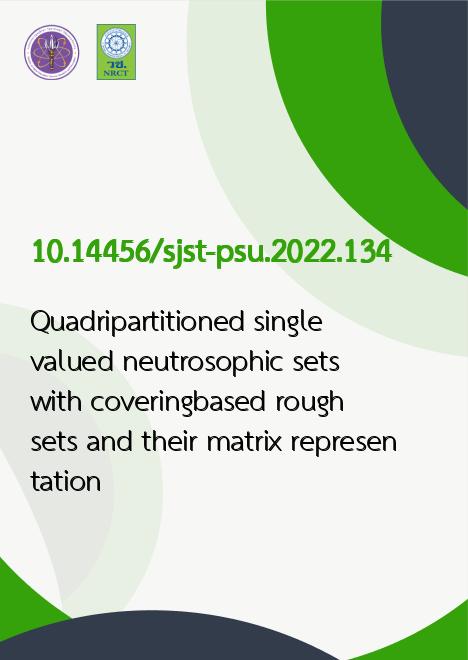
|
Quadripartitioned single valued neutrosophic sets with coveringbased rough sets and their matrix representation |
|---|---|
| รหัสดีโอไอ | |
| Creator | Somen Debnath |
| Title | Quadripartitioned single valued neutrosophic sets with coveringbased rough sets and their matrix representation |
| Publisher | Research and Development Office, Prince of Songkla University |
| Publication Year | 2565 |
| Journal Title | Songklanakarin Journal of Science an Technology (SJST) |
| Journal Vol. | 44 |
| Journal No. | 4 |
| Page no. | 1018-1031 |
| Keyword | covering rough set, quadripartitioned single-valued neutrosophic set, approximation space, decision matrix |
| URL Website | https://rdo.psu.ac.th/sjst/index.php |
| ISSN | 0125-3395 |
| Abstract | The notion of a quadripartitioned single-valued neutrosophic set (in short QSVNS) is considered to be the more generalmathematical framework of the neutrosophic set to model indeterminacy. In QSVNS, the indeterminacy component is dividedinto two parts, namely, โunknownโ and โcontradictionโ. In a real-life scenario, while handling indeterminacy, we may have somehesitation about whether the indeterminacy occurs due to the belongingness or the non-belongingness of an object. This leads tothe introduction of QSVNS. On the other hand, the theory of rough set (RS) is introduced to depict the incomplete data hidden innature with an aid of equivalence relation. So, by combining the QSVNS and the RS, a new mathematical structure known as aquadripartitioned single-valued neutrosophic rough set is formed. The main purpose of this article is to present two types ofquadripartitioned single-valued neutrosophic covering rough set models. Also, we have introduced QSVN ฮฒ-coveringapproximation space and studying some of its properties. Based on QSVN ฮฒ -covering approximation spaces, two types of QSVNcovering rough set models are investigated. Furthermore, a matrix representation of the QSVN covering-based rough set model isdeveloped. Finally, an algorithm-based model under QSVN covering-based rough set is developed and employed in a case studyto diagnose a patient/s that is more likely suffering from a disease having certain symptoms. |
